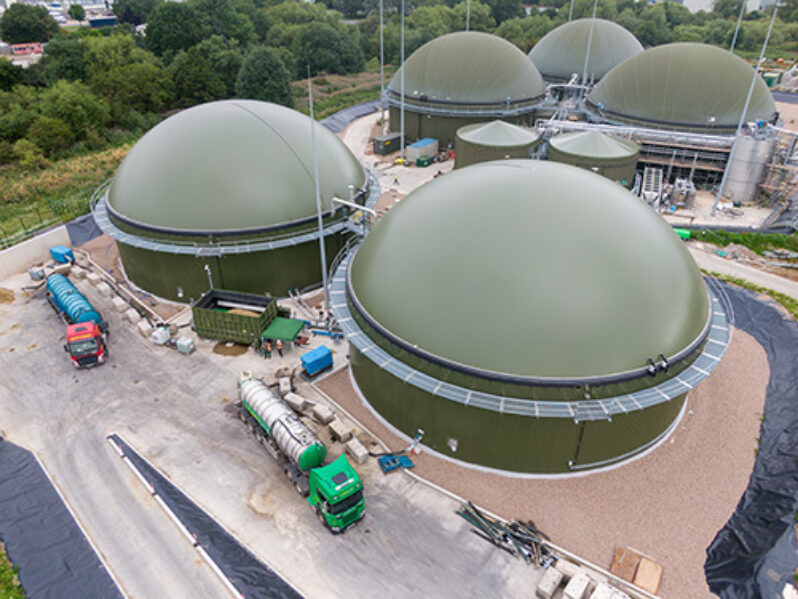Key Facts
Project: Anaerobic digestion food waste plant
Client: Severn Trent Green Power
Location: Derby
Facility footprint: 3 hectares
Purpose: Retrofit and enhancement
Cost: Confidential
Commencement: March 2022
Contract: EPC contract
Output: Gas to grid
VIEW PDF CASE STUDY HERE
Introduction
With a target to increase food waste recycling by 30 tonnes a day, Severn Trent Green Power procured Agrivert to reconfigure an existing anaerobic digestion food waste recycling facility. The goal is to achieve maximum efficiency and operability and bring the Facility into commercial operation by 2023. The contract was awarded to Agrivert in March 2022 and was completed by August 2023.
Objective
The project has four main objectives.
- To redesign and install a new front-end de-packaging and pasteurisation system to increase the efficiency and capacity of the plant.
- To add and integrate two additional digesters to increase capacity.
- To design and integrate a silage feed capability into the plant.
- Lastly, the SCADA and control system needs to be upgraded and made compatible with the client's existing systems elsewhere.
Solution
- The front-end system was changed to adopt a bunker-fed automated hammermill feed system that offers considerably enhanced throughput and a duty and standby capability.
- The post-pasteurisation system has been designed to allow the plant to operate at a peak flow. The new pasteurisation system heats the substrate to 72 degrees Celsius to meet Animal By-Products (ABP) critical control points (CCP) standards.
- Cast in-situ digesters have been installed, allowing additional hydraulic retention time, maximising gas output and facilitating easier planned and unplanned maintenance. In addition, Huning bunkers facilitate the silage feed and ensure robust operations.
Contact Us to discuss our renewable energy solutions
Client
Severn Trent Green Power.
Expertise
As a leader in engineering and operating bio-waste treatment and renewable energy infrastructures, Agrivert has the expertise necessary to complete this project. The project requires engineering, procurement, construction, commissioning, and other services to bring the Facility to working commercial operation.
Agrivert operate, maintain, and enhance renewable energy infrastructure in the UK and internationally and provides advanced technical services to monitor and optimise assets, ensuring maximised efficiency and minimising downtime.
Agrivert's unparalleled engineering and operational experience is delivered by a team of agile and creative engineers and operators. As a result, they can deliver complex infrastructure on time and within budget.

Process
The process for food waste treatment uses a waste Reception Building and a preliminary treatment system located in the Reception Building where food waste is processed into substrate.
- Food waste collection vehicles access the Reception Building, and food waste is placed into a recessed food waste reception bunker.
- Large-diameter screw conveyors move the food waste from the reception bunker into the depackaging mill.
- Robust hammermills depackage the food waste whilst simultaneously sizing it to the required particle size and diluting it to a pumpable state known as 'substrate'.
- The substrate is then pumped to a settling tank where grit is removed. The settling tank also acts as a cold hydrolysis tank to aid digestion and a buffer tank to allow the plant to manage peaks and troughs of feedstock delivery
- The substrate is then pumped to the anaerobic digestion process. In the anaerobic digesters, the substrate will be metabolised by the anaerobic bacteria, leaving digestate and, in the process, generating biogas.
- Pasteurisers sanitise the 'digestate' before onward recycling. This process utilises heat from the CHP engines to batch pasteurise the digestate.
- Extremely durable, high-capacity screw presses filter the pasteurised digestate to remove any remaining plastic particles.
- Biogas generated in the anaerobic digesters is stored in tanks is upgraded and then injected into the grid
Outcomes
This Facility produces renewable energy in the form of biogas that is injected directly into the UK gas grid and a bio-fertiliser, which is spread on local farmland. This Facility also stops over 50,000 tonnes of solid and liquid food waste from entering UK landfills each year whilst providing a local service to the community.
